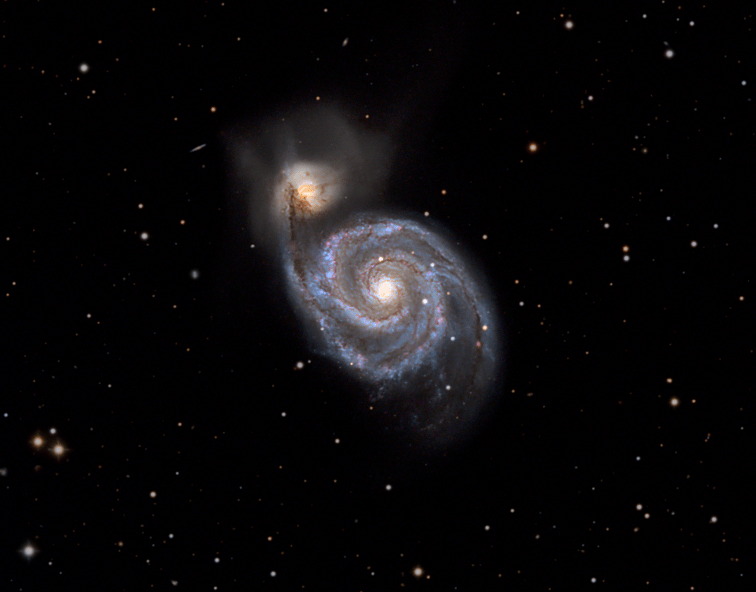
The size and diversity of the cosmos produces many wonderful features, of which M51 the Whirlpool Galaxy ranks highly amongst astrophotographers and is certainly one of my favourites. Unfortunately, it is at the limit for my equipment and location, though in 2020 I was fortunate to capture over 16-hours integration time and a reasonable image (see here). Whilst currently in the summer doldrums of limited darkness, I chose to process M51 data previously obtained using a Takahashi FSQ 106 located at Deep Sky West in New Mexico, USA.
Seen face-on from Earth, the balanced arms of this grand design galaxy contains dark dust lanes, blue star clusters and numerous pink star-forming regions rich in hydrogen gas. But it is the cosmic dance taking place between M51 and its companion dwarf galaxy NGC 5195 that makes this such an exciting and popular object.
The most popular theory of what’s happening, is that the smaller galaxy is passing behind M51 and the joint gravitational forces are interacting between the two, resulting in the misalignment of stars and unusually bright blue and pink areas across the M51 galaxy. Though not certain, it seems that their fates are inextricably linked and might eventually merge. Whatever the process taking place, it will take millions of years if not longer to play out and is likely to provide this exciting spectacle for many generations of astrophotographers yet to come!

Whilst I was satisfied with my image obtained here in Surrey at Fairvale Observatory in 2020, there’s no denying that the data set from New Mexico is in a different league and was a pleasure to process. Given the short focal length of both telescopes, Takahashi FSQ 106 (530mm f5) and William Optics GT 81 (382mm f4.72), out of the camera both set-ups inevitably produce a wide FOV but nonetheless pleasing images (see image above). However, the quality of the DSW data holds up much better when cropping out M51 and its dance partner, thus showing off the aforesaid details of this dynamic and colourful scene to great effect (see top of page).
| IMAGING DETAILS | |
| Object | M51 Whirlpool Galaxy & NGC 5195 |
| Constellation | Canes Venatici |
| Distance | 23 million light-years |
| Size | Approx. 77,000 light-years (M51 only) ~10 arc minutes |
| Apparent Magnitude | -+8.4 |
| Scope | Takahashi FSQ 106 FL 530mm f/5 + Moonlight Nightcrawler focuser |
| Mount | Paramount MyT |
| Guiding | Yes |
| Camera | QSI 683-WSG8 KAF-8300 full frame CCD sensor 5.4nm pixels |
| FOV 1.94o x 1.46o Resolution 2.1”/pix. Image array 3326 x 2,507 pix | |
| Processing | Deep Sky Stacker, PixInsight v1.8.9-1 |
| Image Location & Orientation | Centre – RA 13:29:55.31 DEC +47:11:41.608 Top Left = North |
| Exposures | L x 16, R x 18, G x 16, B x 17 @ 900 sec & -20o C Total Integration Time: 16hr 45min |
| Calibration | 48 x 900 secs Darks x47 Bias & x20 LRGB Flats |
| Location & Darkness | Deep Sky West – amateur hosting facility near Rowe, New Mexico – USA SQM Typically >= 21.7 |
| Date & Time | January 2018 |
